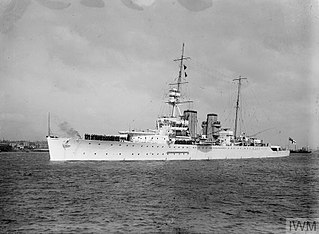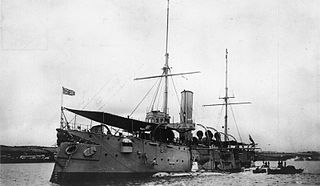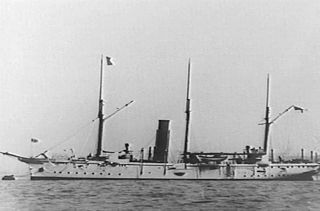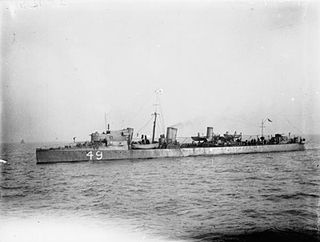
The C class was a group of twenty-eight light cruisers of the Royal Navy, and were built in a sequence of seven groups known as the Caroline class, the Calliope class, the Cambrian class, the Centaur class, the Caledon class, the Ceres class and the Carlisle class. They were built for the rough conditions of the North Sea, and proved to be rugged and capable vessels, despite being somewhat small and cramped.

HMS Cleopatra (F28) was a Leander-class frigate of the Royal Navy (RN). Cleopatra was built at HMNB Devonport. She was launched on 21 March 1964, commissioned on 1 March 1966 and decommissioned on 31 January 1992.

HMS Danae was a Leander-class frigate of the Royal Navy. She was, like the rest of the class, named after a figure of mythology. Danae was built by Devonport Dockyard. She was launched on 31 October 1965 and commissioned on 10 October 1967.

HMS Antelope was a Royal Navy Alarm-class torpedo gunboat. She was launched in 1893, reduced to harbour service from 1910 and was sold for scrapping in 1919.

The Arethusa-class cruisers were a class of eight oil-fired light cruisers of the Royal Navy all ordered in September 1912, primarily for service in the North Sea. They had three funnels with the middle one somewhat larger in diameter than the others. All served in the First World War. They were found to be very cramped internally.

The Tribal or F class was a class of destroyers built for the Royal Navy. Twelve ships were built between 1905 and 1908 and all saw service during World War I, where they saw action in the North Sea and English Channel as part of the 6th Flotilla and Dover Patrols.

HMS Hermione was a Dido-class light cruiser of the Royal Navy. She was built by Alexander Stephen and Sons, with the keel laid down on 6 October 1937. She was launched on 18 May 1939 and commissioned 25 March 1941. On 16 June 1942, Hermione was torpedoed and sunk by the German submarine U-205 in the Mediterranean. Eighty-eight crewmembers were killed.

HMS Effingham was one of five Hawkins-class heavy cruisers built for the Royal Navy during the First World War. She was not finished during the war and construction proceeded very slowly after the end of the war in 1918. Completed in 1925, the ship was assigned to the East Indies Station, sometimes serving as a flagship. She returned home in 1932 and was assigned to the Reserve Fleet as its flagship for the next four years. Effingham was rearmed and modernized in 1937–1938 and then resumed her previous role.

The Acasta class was a class of twenty destroyers built for the Royal Navy under the Naval Programme of 1911 - 1912 that saw service during World War I. They were the last class of Royal Navy destroyers to have mixed names with no systematic theme When the class was designated as "K", names beginning with that letter were allocated to the ships but never used. The class saw extensive wartime service and seven were lost, including four at the Battle of Jutland.

HMS Andromeda was one of eight Diadem-class protected cruisers built for the Royal Navy in the 1890s. Upon completion in 1899, the ship was assigned to the Mediterranean Fleet where she helped to escort a royal yacht during its cruise through the Mediterranean Sea. After a refit, she was assigned to the China Station in 1904 and returned home three years later to be reduced to reserve. Andromeda was converted into a training ship in 1913 and remained in that role under various names until 1956. That year she was sold for scrap and broken up in Belgium, the last Pembroke-built ship still afloat.

HMS Carysfort was a C-class light cruiser built for the Royal Navy during World War I. She was one of six ships of the Caroline sub-class and was completed in 1915. Assigned to the Grand Fleet, the Harwich Force, and the Dover Patrol during the war, the ship served as a flagship for part of the war. Her only known combat was a short battle against German torpedo boats in the English Channel, although she was very active patrolling the North Sea and unsuccessfully searching for German ships. Carysfort was assigned to the Home and Atlantic Fleets after the war and was sent to the Mediterranean Fleet during the Chanak Crisis of 1922–23 to support British interests in Turkey. In 1922, she patrolled off the Irish coast during the Irish Civil War. The ship was placed in reserve after returning home in 1923 and, aside from ferrying troops overseas, remained in reserve until she was sold for scrap in 1931.

HMS Thames was a Mersey-class protected cruiser built for the Royal Navy (RN) in the 1880s. The ship was placed in reserve upon her completion in 1888 and was converted into a submarine depot ship in 1903. She was sold out of the navy in 1920 and was purchased by a South African businessman to serve as a training ship for naval cadets under the name SATS General Botha. The ship arrived in South Africa in 1921 and began training her first class of cadets in Simon's Town the following year. General Botha continued to train cadets for the first several years of World War II, but the RN took over the ship in 1942 for use as an accommodation ship under her original name. She was scuttled by gunfire in 1947 and is now a diveable wreck.

HMS Frobisher was one of five Hawkins-class heavy cruisers built for the Royal Navy during the First World War. She was not finished during the war and construction proceeded very slowly after the end of the war in 1918. Completed in 1924, the ship was initially assigned to the Mediterranean Fleet and was transferred to the Atlantic Fleet in 1929, sometimes serving as a flagship. Placed in reserve in 1930, Frobisher was converted into a cadet training ship in 1932 before being returned to reserve in 1937. Two years later she was reactivated to again serve as a training ship.

HMS Sentinel was one of two Sentinel-class scout cruisers built for the Royal Navy in the first decade of the 20th century. The ship was initially assigned to the Mediterranean Fleet before returning home and being reduced to reserve in 1907. Recommissioned two years later as part of the Home Fleet, she spent the next five years moving on and off of active service in British waters. Sentinel was assigned to coastal defence duties when the First World War began in 1914, although she was transferred to the Mediterranean in 1915. By 1918 the ship had been assigned to the Aegean. After the end of the war in November, Sentinel was sent to the Black Sea as the British attempted to intervene in the Russian Civil War. The ship returned home in early 1919 and was paid off. She became a training ship from mid-1920 to the end of 1922 and was sold for scrap in early 1923.

The Challenger-class cruisers were a pair of second-class protected cruisers built for the Royal Navy in the first decade of the 20th century. One ship, HMS Encounter, was later transferred to the Royal Australian Navy.

HMS Wild Swan was an Osprey-class sloop built for the Royal Navy in the mid-1870s. She was launched in 1877 and became a base ship in 1904, being renamed Clyde. She was renamed Columbine in 1913 and was sold for breaking in 1920.

HMS Archer was an Archer-class torpedo cruiser of the British Royal Navy which was built by the Glasgow shipbuilder J & G Thomson between 1885 and 1888. She served on overseas stations, including operations off Africa, China and Australia. She was sold for scrap in 1905.

HMS Kestrel was a Clydebank-built three funnelled 30-knot destroyer ordered by the Royal Navy under the 1895 – 1896 Naval Estimates. She was the fourth ship to carry this name since it was first used in 1846 for a brigantine.

HMS Serpent, was an Archer-class torpedo cruiser of the Royal Navy. Serpent was built at Devonport Dockyard, entering service in 1888. She was lost when she ran aground off Cape Vilan in northwest Spain with the loss of 173 people out of 176 in her crew.
HMS TB 13 was a Cricket-class coastal destroyer or torpedo-boat of the British Royal Navy. TB 13 was built by the shipbuilder J S White from 1907 to 1908. She was used for local patrol duties in the First World War and was sunk following a collision on 26 January 1916.




















